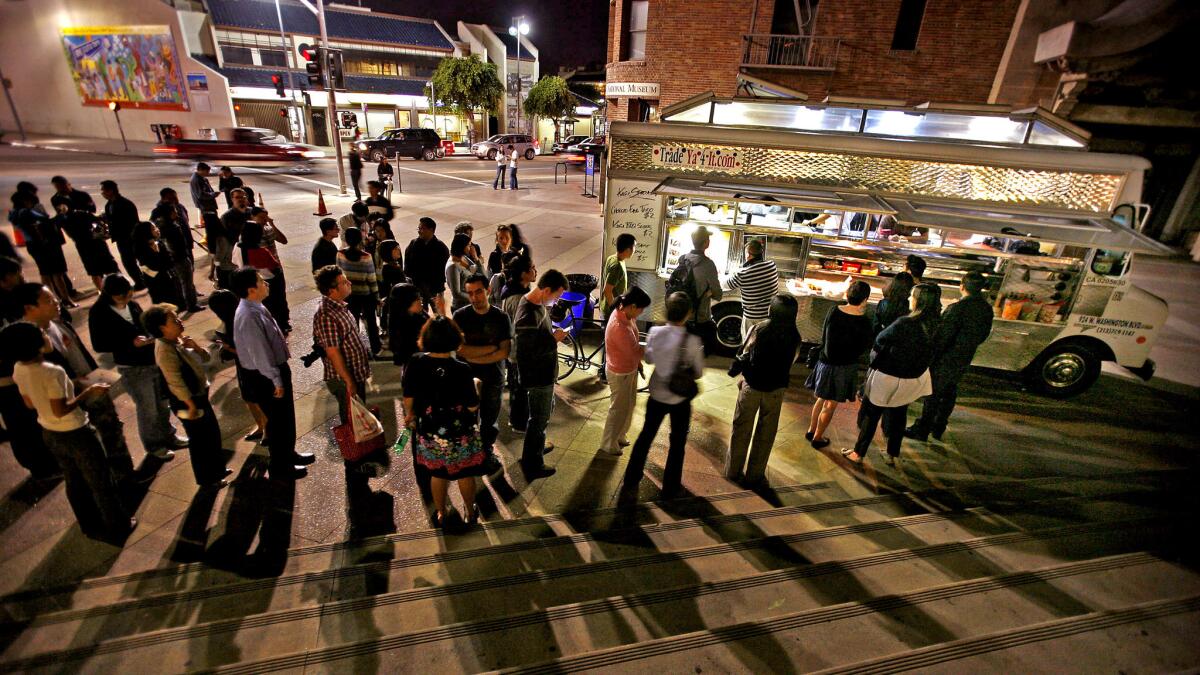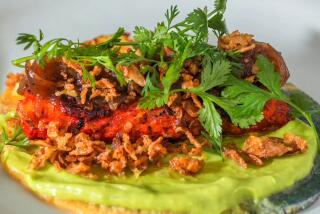‘Mexican food always wins’: José R. Ralat on his new book ‘American Tacos’
- Share via
José R. Ralat made headlines last fall when Texas Monthly, the “national magazine of Texas,” appointed him the publication’s first-ever taco editor. The role requires him to travel the state for about two weeks every month to report on the state’s expansive taco scene.
It wasn’t an easy job to get; Ralat pitched the idea to the magazine nearly four years ago. Before that, he wrote about tacos for more than a decade, most notably in his long-running blog Taco Trail, which started as a weekly column in the Dallas Observer in 2010.
I spoke to Ralat recently from his home in Dallas, where he is temporarily grounded but busy promoting his new book, “American Tacos.” It’s a deeply researched guide to north-of-the-border taco culture and history. We talked at length about the diversity of regional American taco styles, the rise of “Sur-Mex” tacos, and why he says “Mexican food always wins.” Our conversation has been edited for length and clarity.
“American Tacos” is now available in bookstores.
What is your working definition of an “American taco”?
Not much different from my definition of a taco. Tacos developed at about the same time on both sides of the river before there was a border. Each country had its own taco traditions from nearly the beginning. Mexicans have folded things in tortillas for thousands of years but they weren’t always called tacos — and we can debate that forever — but I think a taco is a representation and reflection of its time and place. It’s regional. And that regionality includes this country, Mexico’s sister country.
Regionality means that what goes into the tortilla depends on populations, what’s available and what people want to eat. After the war of 1848 and the border demarcation that cleaved markets, ingredient availability changed north of the border. Taco development in this country took off in different directions. Those directions are American tacos. The American taco, as I note, comes to prominence at the end of the 19th century but really doesn’t take hold until technology like refrigeration becomes widely available. That’s when you get Tex-Mex, that’s when you get fried tacos.
You note that fried crispy tacos have a long history in this country, but I still run into people who tell me that they’re somehow not authentic.
The crispy taco is a glorious thing. Some of our earliest recipes called for frying the tortilla — not to the extent that we do it now, of course. But the crispy taco is part of this country’s food traditions and it should be respected as such. Unfortunately, mass production — things like boxed taco kits — at some point those became inevitable. But there’s nothing finer than a freshly fried crispy taco. In Texas, they’re actually becoming more common now with increased Mexican immigration.
The Midwest is where you can find freshly fried crispy tacos of many different regionalities. In Chicago I found one built with picadillo — filled, deep-fried and served with a Kraft single slice of cheese, at an Irish pub. It’s that integrated into the culture. Then you get the Kansas City taco, which is a product of Mexican and Italian laborers living side by side, trading ingredients. It’s relatively new, which surprises me, because Kansas City, Mo., has always had Mexicans. They drove cattle all that way from Mexico. It wasn’t until another population came to work at the meat-packing plants that these tacos really developed.
You coin a phenomenon that you name the “Abuelita Principle.” Can you describe what you mean?
So much of the conversation about Mexican food is driven by personal experience that says more about the person arguing than the subject.
I think we forget that Mexico and Mexican food is so much bigger than we can ever imagine. Because the culture and the food is so centered on the family, we gravitate toward the matriarch who was always responsible for the food. The argument is ultimately: “That’s not Mexican food. My grandmother made real Mexican food.” OK, well, what if your grandmother was a terrible cook? Your grandmother’s recipe wasn’t the only recipe.
How I like to frame it to Anglos is using cookies as an example: Your grandmother’s chocolate chip cookie recipe was different than your neighbor’s chocolate chip cookie recipe. That doesn’t make either illegitimate.
The point is that we need to understand that just because something exists outside of our realm of experience does not negate it. At best, it’s misguided. At worst, it’s racist. I get this argument more from Anglos than I do other people. [Tacos] ultimately belong to Mexico. They get the final word. Those of us who live in the borderlands are just lucky enough to live in a part of the world that was once Mexico.

You have a chapter called “K-Mex.” Why do you think Korean tacos evolved as quickly as they did?
They have been around ever since a large wave of Korean immigrants to Southern California meant Koreans and Mexicans and Mexican Americans were working and living side by side in the ’80s and ’90s.
Roy Choi deserves a lot of accolades and respect for leveraging something that might have otherwise remained just a regional thing, like the San Antonio puffy taco. He was incredibly smart to use social media in order to advertise it while Twitter was becoming a thing. It allowed for his food to get on the radar across the country. The [Kogi] profile was public. Anyone on Twitter could follow it. If you followed it, you saw how successful it became and how quickly it became successful.
So other Korean Americans saw the opportunity and took that opportunity to capitalize on it. That happened in like two years. It became an American taco and part of the taco canon. K-Mex is critical to the story of the regional American taco because of its quick success.
In the chapter on “Sur-Mex,” or Southern-style tacos, you call El Mero in Memphis, Tenn. (from chefs Clarissa and Jacob Dries) one of the best taco operations in the country. What made it so memorable?
It wasn’t trying to be something it’s not. It’s of its place and time. A married couple — a native Memphisian and a Mexican immigrant from Oaxaca who met in Austin, Texas — moved to Memphis because food trucks were legalized and they saw an opportunity to integrate elements of their upbringings. The Southern culinary tradition and the Mexican culinary tradition are both rooted in corn.
They called me last week and said, “We’re just trying to cook us. We’re trying to be us.” I think that’s what tacos should be. So they have a fried chicken taco, which has become very Southern. What’s more Sur-Mex is the albondigas with collard greens taco. I think it’s a natural pairing that expresses the beautiful integration of the two traditions to create a third that is valid, delicious and worthy of respect.
Did you coin the term “Sur-Mex”?
It’s the best term I could come up with that acknowledges both traditions being synthesized in a respectful manner. Sur-Mex should have developed a lot sooner and it should have been codified, but it’s not. You have Mexican American chefs like Oscar Diaz [of the Cortez in Raleigh, N.C.] using locally sourced ingredients in Mexican ways, which is part of the same category. So it’s a larger category that’s still trying to fit into its clothes.
Why do you think Sur-Mex is not better known?
The easiest answer I can think of is racism. There have been Mexicans in the South for hundreds of years, but it took a huge population shift for it to really grab hold. And it took people with vision, like Mike Klank and Eddie Hernandez from [Atlanta’s] Taquería del Sol, to plant the seed. And that was only in the 1990s. Sur-Mex should be a prominent American style. We should all know about it.
Do you think it’s because Southern food in general is resistant to change?
You know what’s not resistant to change? Mexican food. It embraces it. Mexican food always wins. Europeans tried to convince themselves and indigenous tribes that corn was the food of poverty and barbarism, and flour was civilized because it’s what the communion wafer was made from. Flour did not displace corn. Flour became part of the tradition. Mexican food has always fought and always won.
In the chapter called “Alta California Tacos,” you profile several Southern California chefs, including Wes Avila (Guerrilla Tacos), Ray Garcia (B.S. Taquería, Broken Spanish) and Carlos Salgado (Taco María). You make the case that what sets these chefs apart is a strong sense of individuality and place. Can you explain that?
Alta California, I think, is the only style of taco that cannot be removed from its geography. It ceases to exist out of its place because it’s tied directly to the ingredients grown and fished in that part of the world. The name of the area was previously Alta California and people in Baja California talk about it as Alta California to this day.
In terms of individuality, chefs like Wes Avila and Ray Garcia find inspiration in the flavors of their childhood. The same thing with Christine Rivera [of Galaxy Taco]. For Carlos [Salgado], it’s more about the history and flavor profiles. It’s a more intellectual taco experience. And I appreciate that. In the book I mention that I cried when I had his food. Because he gets it. He made me get it.
Being a taco editor sounds like a dream job. Is it everything it’s cracked up to be?
My job is to tell the story of other people and the food that they make. Hopefully I can honor them and humanize them and help other people understand that they shouldn’t be scapegoated. While I’m not Mexican, my son is, and I don’t want him to suffer the kind of racism I did just for being brown-skinned. I want everyone to be treated with respect just because they exist. Mexican cooks and Latinos are among the hardest-working and most welcoming people. We deserve that acknowledgment.
More to Read
Eat your way across L.A.
Get our weekly Tasting Notes newsletter for reviews, news and more.
You may occasionally receive promotional content from the Los Angeles Times.










